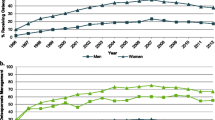Abstract
Introduction
Patients who take chronic glucocorticoids (GC) are at increased risk of osteoporosis and fracture. Only a minority of patients who take chronic GC receive optimal osteoporosis prevention, diagnosis, and/or treatment.
Methods
An organized program of care—GIOP (Glucocorticoid-Induced Osteoporosis Program)—was designed and implemented. The program goals were to identify patients at risk of fracture, provide education, redesign and implement new pathways of care, and monitor outcomes. Two hundred chronic GC users were seen at baseline, and follow-up visits scheduled at 6 months and 1 year.
Results
Patient retention of knowledge, frequent exercise, and 25-OH Vitamin D levels all significantly improved at 1 year. A significant decrease in GC dose was seen. In terms of adherence, 91% of patients considered at high risk were taking a bisphosphonate or teriparatide at 1 year, and 96% of patients overall were adherent to their prescribed regimen of calcium, vitamin D, and prescription treatment (if indicated). Bone density at the spine and total hip increased significantly.
Conclusions
GIOP is the first organized program of care for patients who take chronic GC that has demonstrated a clinically significant improvement in outcome. The program’s design can be adapted and used by other health systems and organizations.

Similar content being viewed by others
References
Saag KG (2003) Glucocorticoid-induced osteoporosis. Endocrinol Metab Clin N Am 32:135–157
Cohen D, Adachi JD (2004) The treatment of glucocorticoid-induced osteoporosis. J Steroid Biochem Mol Biol 88:337–349
American College of Rheumatology Ad Hoc Committee on Glucocorticoid-induced Osteoporosis (2001) Recommendations for the prevention and treatment of glucocorticoid-induced osteoporosis. Arthritis Rheum 44:1496–1503
Brown JP, Josse RG (2002) 2002 clinical practice guidelines for the diagnosis and management of osteoporosis in Canada. CMAJ 167(10 Suppl):S1–S30
Eastell R, Reid DM, Compston J et al (1998) A UK consensus group on management of glucocorticoid-induced osteoporosis: an update. J Intern Med 244:271–292
Solomon DH, Katz JN, Jacobs JP, La Tourette AM, Coblyn J (2002) Management of glucocorticoid-induced osteoporosis in patients with rheumatoid arthritis. Arthritis Rheum 46:3136–3142
Blalock SJ, Norton LL, Patel RA, Dooley MA (2005) Patient knowledge, beliefs, and behavior concerning the prevention and treatment of glucocorticoid-induced osteoporosis. Arthritis Rheum 53:732–739
Naunton M, Peterson GM, Jones G, Griffin GM, Bleasel MD (2004) Multifaceted educational program increase prescribing of preventive medication for corticosteroid induced osteoporosis. J Rheumatol 31:550–556
Solomon DH, Katz JN, La Tourette AM, Coblyn JS (2004) Multifaceted intervention to improve rheumatologists’ management of glucocorticoid-induced osteoporosis: a randomized controlled trial. Arthritis Rheum 51:383–387
Newman ED, Ayoub WT, Starkey RH, Diehl JM, Wood GC (2003) Osteoporosis disease management in a rural health care population: hip fracture reduction and reduced costs in postmenopausal women after 5 years. Osteoporos Int 14:146–151
Newman ED, Ayoub WT, Matzko CK, Wood C (2003) Glucocorticoid-induced osteoporosis-significant improvement in bisphosphonate use utilizing standardized consultative DXA reporting. Arthritis Rheum 48:S499
Canalis E, Bilezikian JP, Angeli A, Giustina A (2004) Perspectives on glucocorticoid-induced osteoporosis. Bone 34:593–598
Van Staa TP, Leufkens HG, Abenhaim L, Zhang B, Cooper C (2000) Use of oral corticosteroids and risk of fractures. J Bone Miner Res 15:993–1000
Sambrook PN (2002) Glucocorticoid osteoporosis. Curr Pharm Des 8:1877–1883
Homik JJ, Cranney A, Shea BJ et al (2005) Calcium and vitamin D for corticosteroid-induced osteoporosis (Cochrane Review) (2005) In: The cochrane library, Issue 4. Wiley, Chichester, UK
Lane NE (2001) An update on glucocorticoid-induced osteoporosis. Rheum Dis Clin North Am 27:235–253
Reid IR (2000) Glucocorticoid-induced osteoporosis. Baillieres Clin Endocrinol Metab 14:279–298
Sambrook PN (2005) How to prevent steroid induced osteoporosis. Ann Rheum Dis 64:176–178
Adachi JD, Saag KG, Delmas PD et al (2001) Two-year effects of alendronate on bone mineral density and vertebral fracture in patients receiving glucocorticoids -a randomized, double-blind, placebo-controlled extension trial. Arthritis Rheum 44:202–211
Cohen S, Levy RM, Keller M et al (1999) Risedronate therapy prevents corticosteroid-induced bone loss -a twelve-month, multicenter, randomized, double-blind, placebo-controlled, parallel group study. Arthritis Rheum 42:2309–2318
Lane NE, Sanchez S, Modin G et al (2000) Bone mass continues to increase at the hip after parathyroid hormone treatment is discontinued in glucocorticoid-induced osteoporosis: results of a randomized controlled trial. J Bone Miner Res 15:944–951
Curtis JR, Westfall AO, Allison JJ et al (2005) Longitudinal patterns in the prevention of osteoporosis in glucocorticoid-treated patients. Arthritis Rheum 52:2486–2494
Harrington JT, Barash HL, Day S, Lease J (2005) Redesigning the care of fragility fracture patients to improve osteoporosis management: a health care improvement project. Arthritis Rheum 53:198–204
Acknowledgements
The authors would like to thank the specialists and primary care providers of the Geisinger Health System for their commitment and assistance in making this program a success and improving the lives of the patients whom we all serve.
Funding: This project was supported in part by an unrestricted educational grant from Merck & Co, Inc.
Author information
Authors and Affiliations
Corresponding author
Additional information
An erratum to this article can be found at http://dx.doi.org/10.1007/s00198-006-0198-7
Rights and permissions
About this article
Cite this article
Newman, E.D., Matzko, C.K., Olenginski, T.P. et al. Glucocorticoid-Induced Osteoporosis Program (GIOP): a novel, comprehensive, and highly successful care program with improved outcomes at 1 year. Osteoporos Int 17, 1428–1434 (2006). https://doi.org/10.1007/s00198-006-0149-3
Received:
Accepted:
Published:
Issue Date:
DOI: https://doi.org/10.1007/s00198-006-0149-3




